|
|
 |
|
Cyclopoida ( Order ) |
|
|
|
Oncaeidae ( Family ) |
|
|
|
Spinoncaea ( Genus ) |
|
|
| |
Spinoncaea ivlevi (Shmeleva, 1966) (F,M) | |
| | | | | | | Syn.: | Oncaea ivlevi Shmeleva, 1966 (p.932, figs.F,M); 1969 (p.5, figs.F,M); Gardner & Szabo, 1982 (p.120, figs. F, M); Malt, 1982 (p.186, Redescr. F,M, figs. F,M); 1983 a (p.8, figs. F,M, Rem.);
Ref. compl.: Kovalev & Shmeleva, 1982 (p.86); Greze & al., 1985 (p.8); Böttger-Schnack & al., 1989 (p.1089); Krsinic & Vilicic, 1989 (p.12, tab.3); Böttger-Schnack, 1992 (p.304); 1994 (p.277); 1997 (p.409); Hure & Krsinic, 1998 (p.104); Krsinic, 1998 (p.1051); Siokou-Frangou, 1999 (p.479); Böttger-Schnack & al., 2001 (p.1029, tab.1, 2); Krsinic & Grbec, 2002 (p.127, tab.1); Selifonova, 2011 a (p.77, Table 1, alien species in Black Sea); | | | | Ref.: | | | Böttger-Schnack, 2003 (p.193, figs.F,M, Rem.: 2 forms); Böttger-Schnack & al., 2004 (p.1130, tab.1, Rem.); Vives & Shmeleva, 2010 (p.329, figs.F,M, Rem.); Böttger-Schnack & Machida, 2011 (p.111, Table 1, fig.2, DNA sequences, phylogeny) | 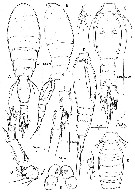 issued from : R. Böttger-Schnack in Zool. J. Linnean Soc., London, 2003, 137. [p.197, Fig.2]. Female, robust form (from Red Sea): A, habitus (dorsal); B, idem (lateral left side); C, urosome (dorsal, seta V on left side missing); D, idem (lateral right side); E, P5-bearing somite and genital double-somite (ventral); F, caudal ramus (dorsal, lanceolate seta V shown separately); G, A1; H, P5 (dorsal); I, idem (ventral); J, genital aperture; K, paired egg-sac. Nota: Proportional lengths (%) of urosomites and caudal rami 7.4:46.0:7.4:8.1:15.9:15.2. Relative lengths (%) of segments of A1 measured along posterior non-setigerous margin 13.2:12.7:40.4:13.2:6.6:13.9. Caudal ramus 1.8 times longer than wide measured along inner margin and 2.3 times longer than wide measured along outer margin (variation in length to width ratio as shown in Table 4)
|
 issued from : R. Böttger-Schnack in Zool. J. Linnean Soc., London, 2003, 137. [p.199, Fig.3]. Female, robust form: A, A2 (lateral elements are numbered using Roman numerals, distal elements are identified by capital letters); B, labrum (anterior); C, idem (posterior); D, Md (showing individual elements, which are identified by capital letters); E, Mx1; F, Mx2; G, Mxp (anterior).
|
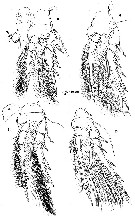 issued from : R. Böttger-Schnack in Zool. J. Linnean Soc., London, 2003, 137. [p.201, Fig.4]. Female, robust form: A, P1 (anterior) [a, 2nd endopod segment, arrow indicating ornamentation on inner margin); B, P2 (anterior); C, P3 (posterior); D, P4 (anterior).
|
 issued from : R. Böttger-Schnack in Zool. J. Linnean Soc., London, 2003, 137. [p.205, Fig.6]. Female, elongate form (from Red Sea): A, habitus (dorsal); B, urosome (dorsal, seta V on caudal rami omitted) [b, P5-bearing somite, ventral, showing midventral spinous processes, exopodal setae omitted]; C, P4 (endopod, anterior, showing reduced inner setae on 2nd segment). Female (from Adriatic Sea): D, habitus (dorsal, pore pattern on prosome not fully discerned); E, urosome (dorsal); F, caudal ramus (dorsal, seta VII shown separately); P4, (endopod, posterior).
|
 issued from : R. Böttger-Schnack in Zool. J. Linnean Soc., London, 2003, 137. [p.206, Fig.7]. Female, robust form (from Monterey Bay): A, urosome (dorsal).
|
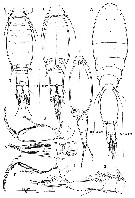 issued from : R. Böttger-Schnack in Zool. J. Linnean Soc., London, 2003, 137. [p.202, Fig.5]. Male (from Red Sea): A, habitus (dorsal); B, Mxp (anterior) [b, idem medial view, claw partly omitted]; C, idem (posterior); D, urosome (dorsal, seta V on caudal rami omitted); E, idem (ventral); E, idem (ventral); F, idem (lateral left side); G, A1 (small middle aesthetasc cose to seta figured separately). Nota: Proportional lengths (%) of urosomites and caudal rami 7.9:52.6:3.4:3.4:4.1:14.3:14.3. Relative lengths (%) of segments of A1 measured along posterior non-setigerous margin 9.0:19.3:40.7:31.0.
|
 issued from : R. Böttger-Schnack in Zool. J. Linnean Soc., London, 2003, 137. [p.198, Table 4]. Variation in length to width ratio (measured dorsally) of urosomites and caudal rami in form variants of female from different geographical regions. N = number of individuals measured (note that measurements represent typical values of specimens for a given area); f. = form; m. = margin.
|
 issued from : A.A. Shmeleva in Bull. Inst. océanogr. Monaco, 1969, 68, n° 1393. [p.6, Fig.3]. As Oncaea ivlevi. Female (from S. Adriatic Sea): a, habitus (dorsal); b, urosome (dorsal); c, A1; d, A2; e, Mxp; f-i, P1 to P4.
|
 issued from : A.A. Shmeleva in Bull. Inst. océanogr. Monaco, 1969, 68, n° 1393. [p.7, Fig.4]. As Oncaea ivlevi. Male: a, habitus (dorsal); b, urosome (dorsal); c, A2; d, Mxp; e-h, P1 to P4.
|
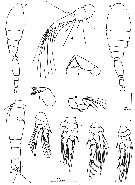 Issued from : S.J. Malt in Bull. Br. Mus. nat. Hist. (Zool), 1982, 42 (3). [p.197, Fig.3]. As Oncaea ivlevi. Female (from 48°N, 7°30'W): a-b, habitus (dorsal and lateral, respectively); c, uosome (dorso-lateral); d, A1; e, A2; f, Mx2; g, Mxp; h, P1; i, P2; j, P3; k, P4. Nota : Ratio of prosome and urosome lengths 1.7 : 1. - 3rd prosomal segment without a dorsal projection. - Proportional lengths of urosome segments and caudal rami 8 : 50 : 7 : 6 : 18 : 11. - Genital apparatus located anterior to midpoint of dorsal surface of genital segment ; each area armed with a setule. - Genital segment not markedly swollen. - Caudal rami nearly twive as long as wide, curving outwards and each bearing a stout spine at external corner. - A1 ratio of segment lengths 19 : 19 : 35 : 12 : 6 : 9. - A2 armature with 1st segment armed with a row of setules on internal surface, and 2nd segment with a row of setules ; terminal segment equal in length to 2 nd segment. - Mxp 4-segmented ; 1st segment unarmed ; internal surface of 2nd segment with 2 spines, longer distal spine spinulose ; 2nd segment also bearing a row of denticles along internal surface ; 3rd segment reduced ; terminal claw bearing a row of spinules along concave surface and an internal basal spine. -Terminal segment of 2 nd endopodite of natatory legs bearing 1 spine on external surface ; endopodites 2, 3 and 4 tipped with relatively small conical projections ; terminal spines of exopodites 1 and 2 slightly longer than terminal segments ; those of exopodites 3 and 4 slightly shorter ; all terminal spines of endopodites shorter than terminal segments and bilaterally flanged. - P5 comprising a small cylindrical free segment bearing 2 setae, outer double length of inner ; and a seta on body surface near the leg.
|
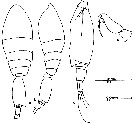 Issued from : S.J. Malt in Bull. Br. Mus. nat. Hist. (Zool), 1982, 42 (3). [p.198, Fig.4]. As Oncaea ivlevi. Male (from 48°N, 7°30'W): a-b, habitus (dorsal and lateral, respectively); c, urosome (lateral); d, Mxp. Nota : Ratio of prosome and urosome lengths 1.6 : 1. - Proportional lengths of urosomal segments and caudal rami 7 : 60 : 2 / 3 : 2 : 13 : 13. - Genital lappets prioduced into small postero-lateral processes. - Genital segment with length to width ratio 2.1 : 1. - Caudal rami twice as long as wide (as in female possessing a dtout spine on each ramus). - Mouthparts similar to those of female except A1 and Mxp. - A1 with three distal segments fused. - Mxp 3-segmented ; 1st segment unarmed ; 2 nd segment bearing 2 short spines and a row of setules on internal surface ; terminal claw bearing spinules on concave surface and a stout external basal spine. - Legs P1-P5 similar to those of female.
| | | | | Compl. Ref.: | | | McKinnon & al., 2008 (p.844: Tab.1); Selifonova & al., 2008 (p.305, Table 2); Nishibe & al., 2009 (p.491, Table 1: seasonal abundance); Böttger-Schnack & Schnack, 2009 (p.131, Table 3, 4); Uysal & Shmeleva, 2012 (p.909, Table I); Gubanova & al., 2013 (in press, p.4, Table 2); Zakaria & al., 2016 (p.1, Table 1, Rem.) | | | | NZ: | 8 | | |
|
Distribution map of Spinoncaea ivlevi by geographical zones
|
| | | | | | | | | | Loc: | | | Atlant. (equatorial), S Celtic Sea, Ibero-moroccan Bay, Medit. (Alboran Sea, Balearic Basin, S Adriatic Sea, Ionian Sea, G. of Saronikos, W Egyptian coast, Lebanon Basin, W Black Sea), G. of Aqaba, Red Sea (N-S), Strait Bab al Mandab, Indian, Australia (North West Cape), Japan (Tosa Bay, Kuroshio region), British Columbia (Vancouver Is.), Monterey Bay | | | | N: | 24 | | | | Lg.: | | | (680) F: ± 0,33; M: 0,35-0,28; (690) F: 0,33-0,32; M: 0,31-0,3; (788) F: 0,34-0,31; M: 0,32-0,28; (913) F: 0,33-0,34; M: 0,31-0,32; (1047) F: 0,3; {F: 0,30-0,34; M: 0,28-0,35} | | | | Rem.: | epipelagic.
This species resembles Oncaea tenella (Sars, 1916).
Depth from 50-500 m.
.
Spinoncaea ivlevi "robust form":
Böttger-Schnack, 2003 (p.204, figs.F)
Spinoncaea ivlevi "elongate form":
Böttger-Schnack, 2003 (p.204, figs.F).
For Malt (1982, p.187) the specimens from the South Celtic Sea differ from Shmeleva’s descriptions in a few minor details in the possession of 3 terminal setae in association with the spine on the caudal rami rather 2 , the possession of an extra row of spinules on both the distal spine on the 2 nd segment of the female mxp and the terminal claw. There are also small differences in the lengths of the terminal exopodite spines. | | | Last update : 16/01/2018 | |
| | | | I don´t agree with the above remark "This species resembles O. tenella Sars". What was the basis for this statement ? Spinoncaea species are clearly different from O. tenella Sars, which in turn is related to O. zernovi and related forms (cf. Böttger-Schnack 2002).
| |
|
|
|
 Any use of this site for a publication will be mentioned with the following reference : Any use of this site for a publication will be mentioned with the following reference :
Razouls C., Desreumaux N., Kouwenberg J. and de Bovée F., 2005-2025. - Biodiversity of Marine Planktonic Copepods (morphology, geographical distribution and biological data). Sorbonne University, CNRS. Available at http://copepodes.obs-banyuls.fr/en [Accessed August 20, 2025] © copyright 2005-2025 Sorbonne University, CNRS
|
|
 |
 |














